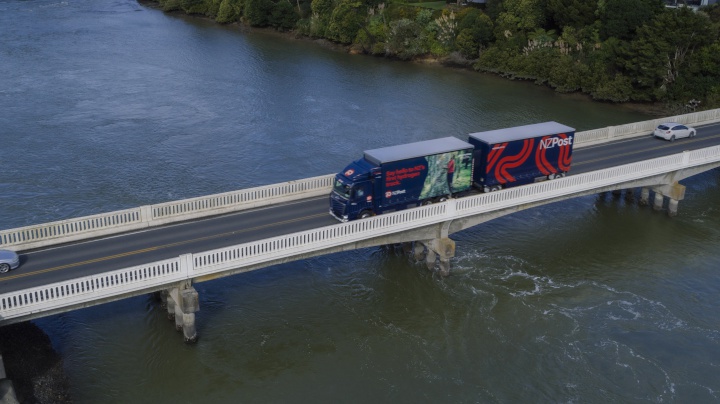Hydrogen Truck Trial – The Future Of Emissions-free Parcel Transport
It sails up the Bombay Hills, accelerates faster than fossil fuel vehicles, and incurs less driver fatigue - some of the key findings from a trial of NZ Post’s new zero emission, hydrogen fuel cell-powered truck.
The zero emission, cutting-edge Hyundai XCIENT FCEV (Fuel Cell Electric Vehicle) is a new generation hydrogen vehicle used for the first time here for commercial heavy transport.
Since it was launched in July last year, it has completed an initial evaluation period before moving into full commercial operations with parcel freight between Auckland and Hamilton to assess its performance on New Zealand roads and conditions.
Heavy transport experts from NZ Post and Hyundai Motors New Zealand evaluating the truck’s performance are thrilled with the results in both open road and urban routes. They hope it will pave the way for uptake of this new technology in the sector as key to reducing carbon emissions.
Based on typical heavy vehicle mileage one fuel cell EV truck in operation avoids the equivalent CO2 of around 112 fossil fuel light vehicles – making a big difference with each heavy fuel cell vehicle.
Ryan Beale, NZ Post’s National Road Operations manager who has been overseeing the trial, says current testing has the hydrogen truck operating around the South Auckland business area and between NZ Post’s South Auckland and Highbrook depots.
Longer-range testing has been between Highbrook and Waikato depots. The truck has been clocking between 350 and 400kms a day, at an optimal cruise speed of 85-88kms, maintaining the same point to point schedule time.
“The testing is to evaluate the vehicle's suitability for our freight and the routes we serve,” says Ryan.
“Within the current constraints, refuelling is taking place in Auckland while we await further network development.”
New, government-funded hydrogen refuelling sites are due to open in Wiri, Te Rapa, Tauranga, and Palmerston North in coming months, enabling refuel in 15 minutes with state-of-the-art technology. These additional fuelling sites will open up longer routes and 24/7 operations.
Ryan says the hydrogen truck configured for European standards and conditions underwent an extensive range of tests and software adjustments to meet operational standards and compliance requirements for New Zealand regulations and road conditions before it was ready for the trial.
Grant Doull, National Manager Hydrogen & Eco Commercial Vehicles at
Hyundai Motors New Zealand says New Zealand is second in world to adopt this technology in a commercial setting.
The other is Switzerland where 50 such trucks in commercial use.
“This project has been two years in the making. This truck is ideal for NZ Post as a transporter of high volume, lower weight freight,” he says.
Evidence and performance data gathered in the trial will be of value to everybody in transport sector, he says.
“It’s been a valuable partnership with NZ Post who are strong in sustainability leadership to trial this future-focussed technology.”
Driver conversion
Neil Dennett, contracted to NZ Post, and the driver for the trial is won over.
“It’s a bloody good truck,” he declares, adding he had no issues other than learning to adapt his driving approach to get the best out of it in terms of the speed-time-fuel ratio.
“Being a fully electric powertrain with a high torque we’ve been able to reduce the cruising speed from 90kms to 85kms to achieve the best economy and greater time saving overall.”
He said the truck sails up the Bombay Hills without losing power or speed.
Neil has been at NZ Post for 30 years, having started as a courier for two years then driving NZ Post freight trucks on contract with Shea Transport Limited.
He admits he hadn't previously identified as being a 'greenie" but through driving the hydrogen truck he’s learned much about the science of emissions and has a new appreciation of the difference driving a vehicle powered with clean fuel can make.
He’s been surprised by another aspect. Driving has been “a different world. You don’t get all the rattles, bangs, the engine noise and all that.”
He feels more refreshed after a shift behind the wheel thanks to the absence of the noises, smells and vibrations that are normal for diesel trucks.
The next stage of the trial is to use it in more urban settings for deliveries. This will allow more customers and the public to see it. Neil says he gets lots of positive comments and interactions with NZ Post staff and members of the public who’ve seen or heard about it.



 NIWA: Antarctic Footprint Clean-up Challenges - How A Remote Antarctic Base Clean-up Protected One Of Earth’s Clearest Lakes
NIWA: Antarctic Footprint Clean-up Challenges - How A Remote Antarctic Base Clean-up Protected One Of Earth’s Clearest Lakes Hugh Grant: Can A Meme Coin Become A Real Payment Solution?
Hugh Grant: Can A Meme Coin Become A Real Payment Solution? Imported Motor Vehicle Industry Association: EV Battery Fires Expose New Zealand Regulatory Gap
Imported Motor Vehicle Industry Association: EV Battery Fires Expose New Zealand Regulatory Gap  Electricity Authority: Electricity Authority Welcomes Plan To Empower Consumers And ‘Make NZ More Electric’
Electricity Authority: Electricity Authority Welcomes Plan To Empower Consumers And ‘Make NZ More Electric’ Pamu Farms: New Zealand Farm Dog Genetic Study Shows Top Five Health Risks
Pamu Farms: New Zealand Farm Dog Genetic Study Shows Top Five Health Risks EDANZ: Payments NZ Forcing The World’s Most Aggressive Removal Of EFTPOS Terminals
EDANZ: Payments NZ Forcing The World’s Most Aggressive Removal Of EFTPOS Terminals


